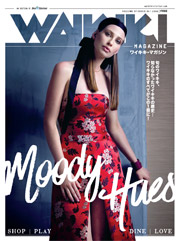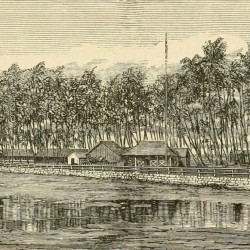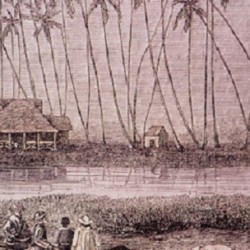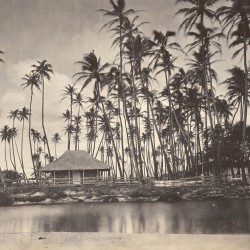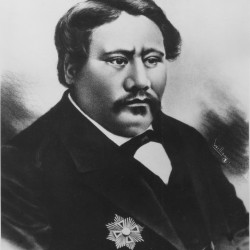Helumoa: The Royal Hawaiian Center
‘OLELO: HO‘I KA WAI A KA PUNA NOHO MAI.
The water returns to the spring and there it remains.
By Lynn Cook
Illuminated by legend, Helumoa glows in the center of Waikiki. It is a wahi pana, a sacred and storied place rich with legends and the spirit of the ancestors. According to tales, told and re-told, the history of Helumoa goes back many hundred years.
- KING KAMEHAMEHA V ONCE CALLED HELUMOA HOME. PHOTOS: COURTESY HAWAI‘I STATE ARCHIVES
In the accounts from ancient times, Ka‘auhelumoa, the phantom rooster, flew from Ka‘au Crater in Palolo Valley, a lush green place folded into the Ko‘olau Mountains above Waikiki. The rooster appeared at the feet of the high chief Kakuhiewa as the chief was relaxing, playing Hawaiian games with his warriors. The rooster began to scratch at the earth. The scratching may have been a sign, or it simply amused the chief. He gave the place a name, hele, to scratch, moa, the chicken. The chief ordered a coconut tree be planted on the spot. From that first planting, a grove of 10,000 coconut trees flourished.
Imagining the site of 10,000 coconut trees in the center of Waikiki became harder to do as concrete monoliths rose from the agricultural land and fish ponds. The flow of the natural ‘awai, the streams was changed. Offspring of those original niu trees survived along Kalakaua Avenue and in the gardens of the Royal Hawaiian Hotel, but even the view of the Pink Palace was blocked from view by a three-block long shopping center.
Today the coconut trees and lush glow of growth are back. Kamehameha Schools, the landowner, removed the center buildings to create a lush park. As it was hundreds of years ago, the Royal Grove is wrapped around the bubbling pond of the ‘Apuakehau stream that runs underground, bringing fresh water from the valleys and mountain tops. Royal Hawaiian Center has been revitalized and opened to the beauty of the gardens. The pink of the Royal Hawaiian Hotel shines through the palms.
A large stage, wrapped around a giant banyan tree, welcomes hula groups as they dance both modern and ancient hula, Polynesian dances and some of Hawai‘i’s top contemporary musicians perform every day. A lawn seating area makes photography easy. Every Saturday evening, Merrie Monarch Hula Festival award-winning hula is danced in the ancient kahiko style. Helumoa is one of the only locations to see this cultural gem of dance.
Beside the pool stands a bronze statue of Princess Pauahi, created by Kamehameha Schools graduate, internationally known sculptor Sean Kekamakupa‘a Ka‘onohiokalani Lee Loy Browne. The statue of the Princess sits on a circular platform of pohaku, stones, and ‘ili‘ili, water-worn pebbles, gathered from Kiholo in North Kona on Hawai‘i Island. Billy Fields, who is an expert in Hawaiian masonry, created the stonework surrounding the statue. The 1-1/3 life-size statue of Pauahi is seated on a bench, holding a book, sharing a story with a small girl. The dress Pauahi wears is one of her own design. “Who we are. Where we are. Where we come from,” are questions that Princess Bernice Pauahi Bishop might have asked the students to consider when she established Kamehameha Schools in 1887.
The gardens are planted with indigenous and endemic tropical flora, favorites of the Princess. In addition to the coconut trees, the gardens are home to native gardenia, ti leaf, shell ginger, tamarind, banyan, hala and ferns; including palapalai, kupukupu, ‘ekaha, hapu‘upu‘u and laua‘e. The pool has water lilies and kalo, or taro, fruit of the land.
Visitors are invited to learn. Signs are all in the Hawaiian language.
Buildings, with Hawaiian names, have design elements that reflect Hale Ili, for the bark of the coconut tree, Hale ‘Aha, reflecting the design of the cordage made from coconut fiber, and Hale Lau, designed after the graceful coconut frond leaf. On the second level, massive murals, telling epic tales of Helumoa, were created by Hawaiian artist Solomon Enos.
The Center has long been a favorite for both locals and visitors looking to enjoy short, cultural experiences through hula, lei making, and ‘ukulele lessons that run. Classes and entertainment run daily from 9:30 a.m. to 8 p.m. New to the coconut grove are Hawaiian storytelling sessions by master storyteller Tom Cummings, and a class in beginning
lomi lomi, Hawaiian massage. Class information is available in the guest services room that opens onto the garden. Helumoa Hale room features a multi-media presentation on the Helumoa story, the life and work of Princess Pauahi and Kamehameha Schools and the vibrancy of the arts and culture of Hawaiians of today.
Check royalhawaiiancenter.com for class and entertainment schedules.



